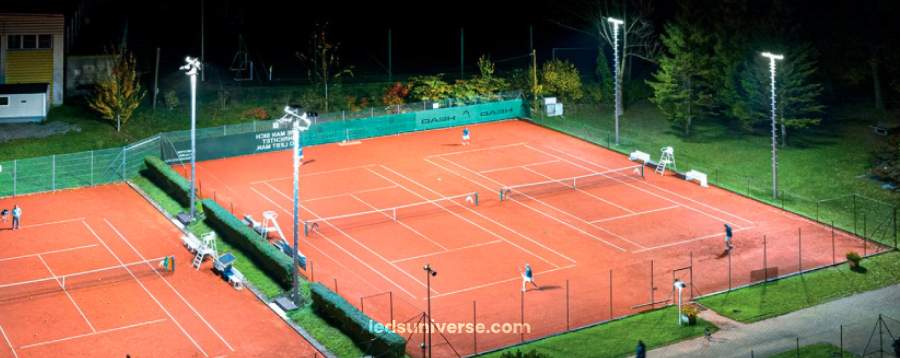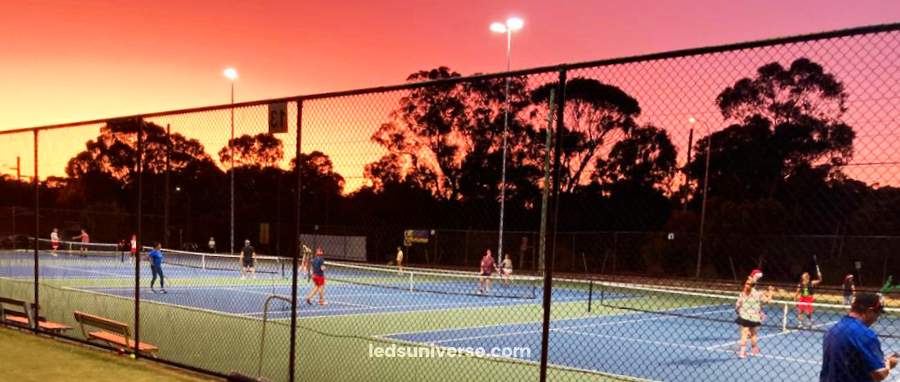Upgrading tennis court lighting can transform a facility from ordinary to extraordinary, and various grants are available to help make these improvements a reality. Government grants, private and non-profit contributions, and support from sports associations each offer unique funding opportunities.
Tennis is a sport that thrives under the lights, extending play into the evening hours and making it accessible to more players. However, installing high-quality lighting systems for tennis courts can be a significant financial investment. Fortunately, various grants are available to assist clubs, schools, and municipalities with these costs.
Reach out for free lighting consultation
Table of Contents
ToggleGovernment grants are a prominent source of funding for tennis court lighting projects. These grants are often provided at the federal, state, or local level, and they aim to support community sports initiatives, enhance recreational facilities, and promote healthy lifestyles. Government grants typically require an application process and may have specific eligibility criteria, such as serving a certain number of residents or promoting community engagement.

Private organizations and non-profits also offer grants for sports lighting projects. These grants may come from foundations dedicated to sports development, local business sponsorships, or charitable organizations that support community sports initiatives. Unlike government grants, private and non-profit grants may have more flexible criteria and can sometimes be easier to obtain, especially for smaller projects or less formal organizations.
Sports associations and federations, such as the USTA (United States Tennis Association), often provide grants to improve tennis facilities. These organizations are particularly focused on the development of the sport and may offer funding for lighting as part of broader facility enhancement projects. Grants from sports associations may include not only financial support but also technical assistance and expertise.
The amount of funding available through tennis court lighting grants can vary widely depending on the source of the grant and the scope of the project. Government grants might offer substantial amounts, often covering a significant portion of the project costs, though they may also require a match from the applicant. Private and non-profit grants can vary from small, partial funding to larger amounts that cover a majority of the expenses.
Typically, grants cover various aspects of the lighting installation, including the purchase of lighting fixtures, installation costs, and sometimes even ongoing maintenance. However, it is essential to read the specific terms and conditions of each grant to understand exactly what costs are covered and any requirements for financial contributions from the applicant.
Before applying for a grant, thorough research and preparation are crucial. Begin by identifying the grants for which your project is eligible. This involves researching government programs, private foundations, sports associations, and any other potential funding sources. Each grant will have specific eligibility requirements, application deadlines, and documentation needs.
Prepare a comprehensive project plan that outlines the scope of the lighting project, including details on the current condition of the tennis courts, the proposed lighting solution, and the anticipated benefits. This plan will be essential for convincing grant reviewers of the project’s value and impact.
The application process for tennis court lighting grants typically involves several steps. Most grants require a detailed proposal or application form, which includes information about the project, the budget, and the organization applying for the grant. The proposal should be clear, concise, and tailored to meet the grant provider’s criteria.
Some grants may require additional documentation, such as proof of community support, letters of endorsement, or evidence of matching funds. It is important to ensure that all required documents are submitted and that the application is completed in full to avoid delays or disqualification.
Once submitted, grant applications undergo a review process. This may involve evaluation by a panel of experts, community representatives, or grant administrators. The review process assesses the feasibility of the project, its alignment with the grant’s goals, and the potential impact on the community.
If your application is successful, you will receive notification of the grant award, including details about the amount of funding and any conditions attached to it. Be prepared to provide regular updates on the project’s progress and financial reporting as required by the grant provider.
Many grants available for tennis court lighting projects include a requirement for matching funds or co-funding. This stipulation means that while the grant will cover a portion of the overall project costs, the applicant must provide additional financial resources to complete the funding. Understanding and preparing for these requirements is crucial to securing and effectively utilizing grant funding.
Matching funds are a common condition attached to grants, designed to demonstrate the applicant’s commitment and investment in the project. Generally, grants will specify the ratio of funding they will provide compared to the amount the applicant must contribute. For instance, a 1:1 match means that for every dollar granted, the applicant must contribute an additional dollar. This ratio can vary widely, with some grants requiring a higher match, such as 2:1, while others may offer more flexible terms or partial funding without a strict match requirement.

Begin by integrating these costs into your project budget from the outset. You need to determine the total cost of the project and calculate the amount of matching funds required based on the grant’s stipulations. This approach will provide a clear understanding of the financial resources needed beyond the grant money. Ensuring that you have a well-thought-out budget will not only help in managing the project efficiently but also in presenting a convincing case to grant reviewers.
Finding sources for the required matching funds can be one of the more challenging aspects of the grant application process. To gather the necessary additional financing, you might consider various strategies. Organizing fundraising events, such as charity tennis tournaments, community dinners, or auctions, can be effective. These events not only raise funds but also engage the community and foster a sense of ownership and involvement in the project.
Reaching out to local businesses for sponsorships or donations is another viable strategy. Many businesses are willing to support community projects, especially if they see a direct benefit to their customer base. In return, you can offer them recognition and promotional opportunities. Engaging with community members to gather individual donations is also a crucial method. A crowdfunding campaign can attract contributions from individuals who are passionate about improving local sports facilities.
Additionally, exploring partnerships with sports organizations, local governments, or other entities interested in co-funding the project can provide significant support. These partnerships might offer both financial and logistical resources, helping to bridge the gap between the grant funding and the total project cost.
When applying for a grant with matching fund requirements, it is essential to clearly demonstrate your commitment and capability to secure the additional financing. Including detailed plans and evidence of your fundraising efforts or commitments from other funding sources in your grant application can strengthen your case. This not only shows that you are serious about the project but also enhances your credibility with grant reviewers.
Once you have secured the matching funds and the grant has been awarded, effective management and reporting become vital. Keeping thorough records of all financial transactions related to both the grant and the matching funds is necessary. Many grants require periodic reporting to demonstrate how the funds are being used and to ensure compliance with grant conditions. Proper documentation and transparent reporting can help maintain a good relationship with the grant provider and facilitate future funding opportunities.
By understanding and preparing for matching fund requirements, you can significantly enhance your chances of successfully obtaining and utilizing a grant for tennis court lighting. Effective preparation, resource identification, and diligent management are key to meeting these financial commitments and ensuring the successful completion of your project.
Securing a tennis court lighting grant can bring a range of benefits to both the facility and the broader community. From enhancing playability to improving safety and boosting facility appeal, the advantages of well-lit tennis courts are substantial.
One of the primary benefits of installing high-quality lighting on tennis courts is the increase in usability. With proper lighting, courts can be used well into the evening, allowing players to enjoy the game regardless of the time of day. This extended playtime is especially beneficial for recreational players who might have busy schedules and cannot always play during daylight hours. Additionally, it provides more opportunities for organized matches and tournaments, which can accommodate players who prefer evening games.
Adequate illumination helps reduce the risk of accidents and injuries by ensuring that players can see the court lines, net, and ball clearly. This is particularly important during evening play when natural light is insufficient. Well-lit courts minimize the likelihood of collisions, trips, and falls, contributing to a safer playing environment for all users.
Bright, modern lighting enhances the visual appeal of the courts, making them more inviting for potential users. This improved aesthetic can attract more players, both new and existing, and increase participation rates. For facilities looking to host tournaments or community events, enhanced lighting can make the courts more appealing to organizers and spectators.
For schools and community centers, upgrading to better lighting can enhance the overall value of the facility. Well-lit courts not only improve functionality but also contribute to the facility’s reputation as a high-quality, well-maintained venue. This can lead to increased usage and potentially higher enrollment or membership rates. Enhanced facilities often become more attractive to potential sponsors and partners, further contributing to their value and sustainability.
In educational settings and community centers, better lighting on tennis courts can create a more enjoyable environment for students and local residents. For schools, it provides students with the opportunity to participate in sports activities after school hours, promoting physical fitness and healthy lifestyles. In community centers, improved lighting can support various programs and events, fostering a greater sense of community and engagement.
Tennis court lighting grants provide valuable financial support for upgrading and installing lighting systems, making it possible to improve facilities and extend playtime. Understanding the types of grants available, the funding amounts and coverage, and the application process are crucial steps in securing this funding. By thoroughly preparing your application, meeting eligibility requirements, and exploring various funding sources, you can enhance your tennis facility and contribute to the growth and enjoyment of the sport in your community.